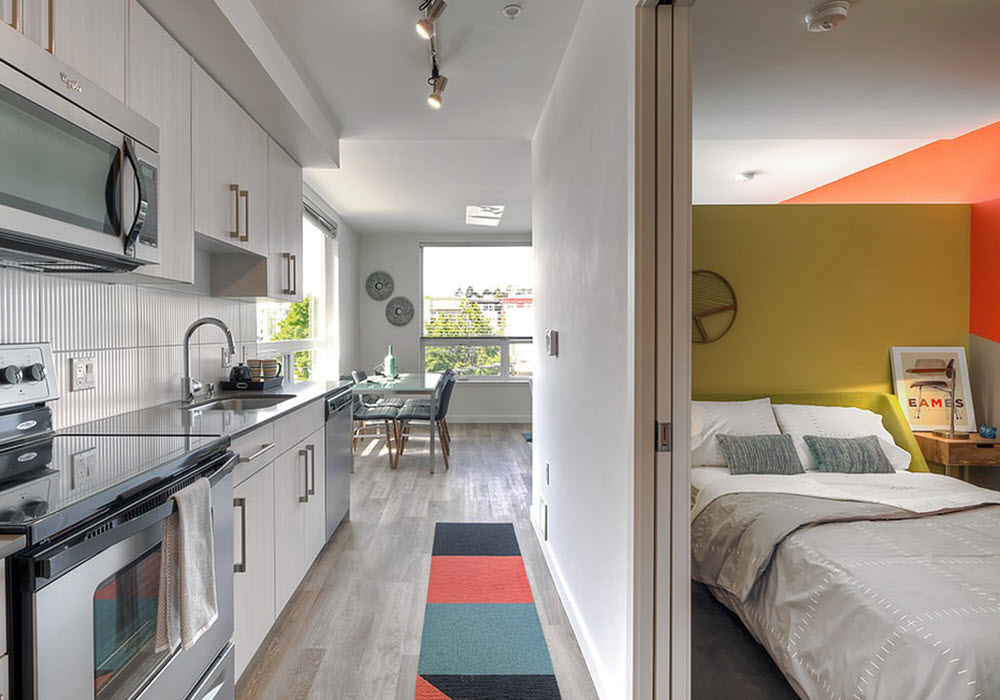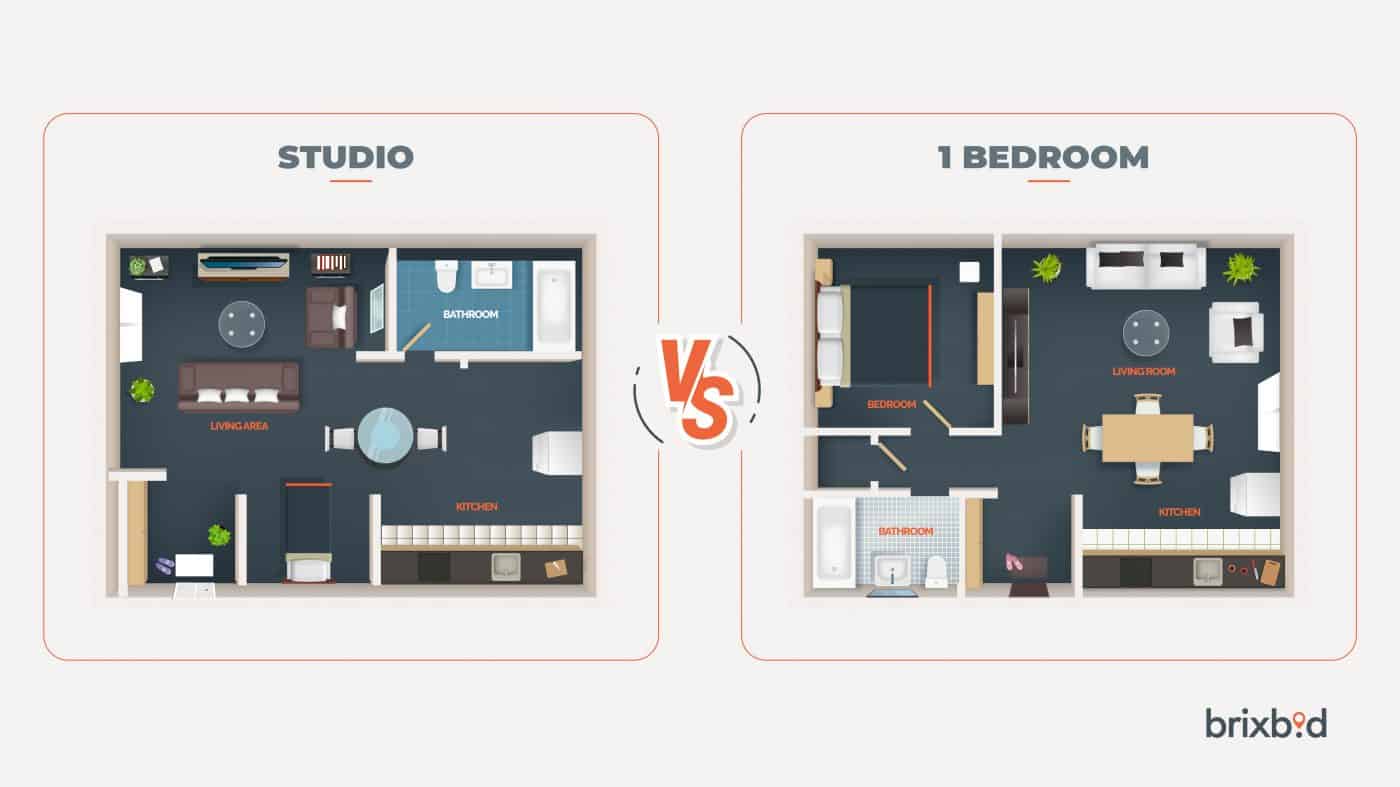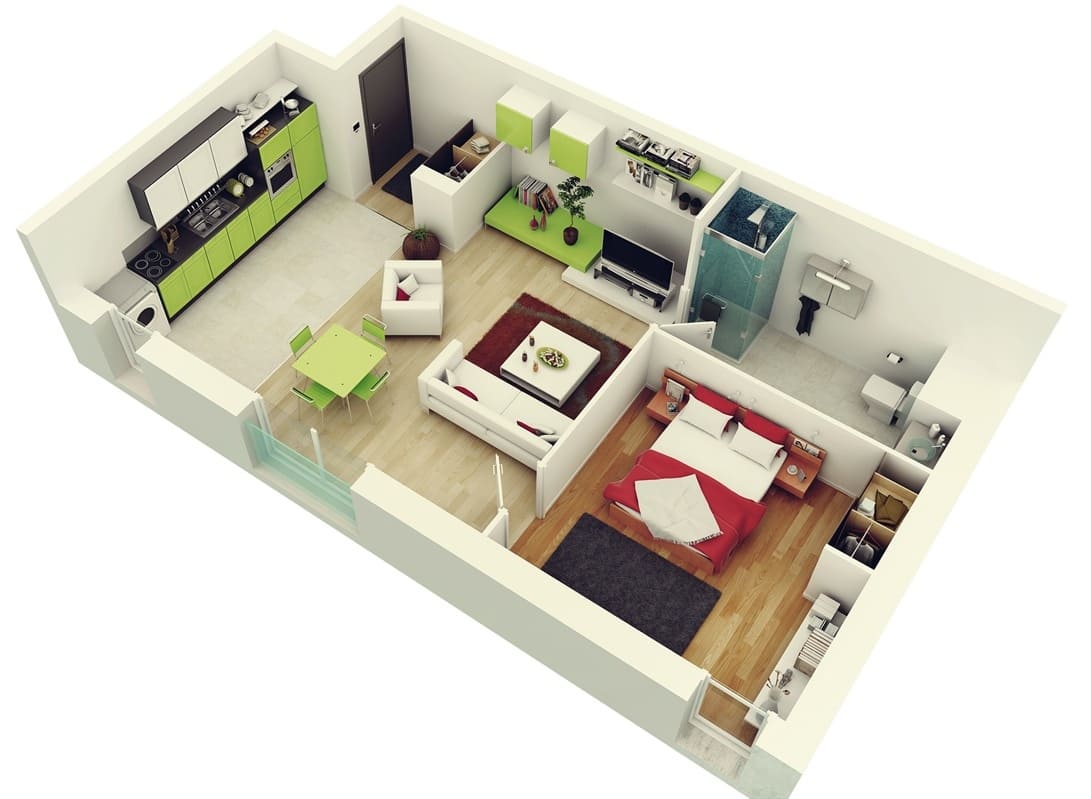Space and Functionality

Studio apartments and 1-bedroom apartments offer different living spaces, each with its own set of advantages and disadvantages. The choice between the two depends on individual needs and preferences.
Typical Square Footage
The size of a studio apartment typically ranges from 300 to 600 square feet, while a 1-bedroom apartment is generally larger, ranging from 500 to 800 square feet. However, these are just general estimates, and the actual square footage can vary significantly depending on the location and the specific building.
Common Layouts and Features
- Studio Apartment: A studio apartment typically combines the living, sleeping, and cooking areas into one open space. The kitchen is often integrated into the main living area, and the bathroom is usually separate. Some studios may have a small alcove or a partition to create a semblance of a bedroom.
- 1-Bedroom Apartment: A 1-bedroom apartment features a separate bedroom, typically with a door for privacy, along with a living room, kitchen, and bathroom. The layout can vary, with some apartments having a more open floor plan and others with more defined spaces.
Advantages and Disadvantages
- Studio Apartment:
- Advantages: Studios are typically more affordable than 1-bedroom apartments, making them a good option for individuals or couples on a budget. They are also generally located in more central areas, offering easy access to amenities and public transportation.
- Disadvantages: The lack of separation between living and sleeping areas can be a challenge for some people, especially those who prefer more privacy or who work from home. The limited space can also make it difficult to store belongings and furniture.
- 1-Bedroom Apartment:
- Advantages: A 1-bedroom apartment offers more privacy and space for living, working, and entertaining. It also provides a dedicated area for sleeping, which can improve sleep quality and reduce distractions.
- Disadvantages: 1-bedroom apartments are generally more expensive than studios. They may also be located in less central areas, requiring longer commutes or less access to amenities.
Cost and Value

The decision between a studio and a 1-bedroom apartment often hinges on budget. This section explores the average rental and purchase prices for each type, examines factors influencing cost, and compares the value proposition in terms of affordability.
Rental Prices
Rental prices for studios and 1-bedroom apartments vary significantly based on location, amenities, and building age.
- Location: Urban centers typically have higher rental costs than suburban or rural areas. For example, a studio apartment in Manhattan, New York, could cost upwards of $3,000 per month, while a similar unit in a smaller city like Buffalo, New York, might rent for $1,000 per month.
- Amenities: Apartments with amenities like in-building gyms, swimming pools, or laundry facilities often command higher rents. For instance, a studio apartment in a luxury building with a rooftop terrace and concierge service could cost more than a similar unit in a building with basic amenities.
- Building Age: Newer buildings with modern finishes and appliances generally have higher rental prices compared to older buildings. A newly constructed studio apartment with stainless steel appliances and a modern bathroom could rent for more than a similar unit in a vintage building with older fixtures.
Purchase Prices
The purchase prices for studios and 1-bedroom apartments follow similar trends as rental prices.
- Location: Prime locations in desirable neighborhoods tend to have higher purchase prices. For example, a studio apartment in a trendy neighborhood in San Francisco could cost upwards of $1 million, while a similar unit in a more affordable location could cost $500,000.
- Amenities: Buildings with amenities like swimming pools, fitness centers, and parking garages often have higher purchase prices. For example, a 1-bedroom apartment in a luxury building with a concierge service and a rooftop lounge could cost more than a similar unit in a building with basic amenities.
- Building Age: Newer buildings with modern features and energy-efficient appliances generally have higher purchase prices. A newly constructed 1-bedroom apartment with high-end finishes and a balcony could cost more than a similar unit in an older building with outdated fixtures.
Value Proposition
The value proposition of studios and 1-bedroom apartments is often evaluated in terms of price per square foot and overall affordability.
- Price per Square Foot: Studios typically have a lower price per square foot compared to 1-bedroom apartments. This is because they have less space. However, the lower price per square foot may not always translate to a lower overall cost, especially if the studio is located in a highly desirable area.
- Overall Affordability: The overall affordability of a studio or 1-bedroom apartment depends on factors such as income, expenses, and personal financial goals. For example, a studio apartment in a more affordable location may be more financially feasible for someone with a limited budget, while a 1-bedroom apartment in a more desirable location may be a better option for someone with a higher income.
Lifestyle and Preferences: Studio Vs 1 Bedroom

Choosing between a studio and a 1-bedroom apartment often boils down to personal lifestyle and preferences. While both offer unique advantages, understanding your needs and priorities can help you determine the best fit for your living situation.
Lifestyle Considerations for Singles and Couples
The choice between a studio and a 1-bedroom apartment often depends on individual needs and preferences. For singles, a studio apartment can be a cozy and efficient choice, offering a streamlined living experience. However, if privacy and dedicated space for work or hobbies are important, a 1-bedroom apartment might be more suitable. For couples, a 1-bedroom apartment generally provides more space and separation for personal belongings and activities.
Advantages and Disadvantages for Different Living Situations, Studio vs 1 bedroom
- Single Individuals:
- Studio Apartment Advantages: Lower rent, compact and efficient, less cleaning and maintenance.
- Studio Apartment Disadvantages: Limited privacy, lack of dedicated space for work or hobbies, potential clutter.
- 1-Bedroom Apartment Advantages: More space for personal belongings and activities, dedicated space for work or hobbies, increased privacy.
- 1-Bedroom Apartment Disadvantages: Higher rent, more space to clean and maintain.
- Couples:
- Studio Apartment Advantages: Lower rent, compact and efficient, potential for creative furniture arrangements to maximize space.
- Studio Apartment Disadvantages: Limited privacy, lack of dedicated space for work or hobbies, potential clutter.
- 1-Bedroom Apartment Advantages: More space for personal belongings and activities, dedicated space for work or hobbies, increased privacy.
- 1-Bedroom Apartment Disadvantages: Higher rent, more space to clean and maintain.
- Roommates:
- Studio Apartment Advantages: Lower rent, compact and efficient, potential for shared living space.
- Studio Apartment Disadvantages: Limited privacy, potential for conflict over shared space, lack of dedicated space for each roommate.
- 1-Bedroom Apartment Advantages: More space for personal belongings and activities, potential for a dedicated room for each roommate, increased privacy.
- 1-Bedroom Apartment Disadvantages: Higher rent, more space to clean and maintain.
Design Ideas and Furniture Arrangements
- Studio Apartment:
- Maximize Space: Utilize multi-functional furniture, such as a sofa bed or a Murphy bed that folds away, to create a flexible living space.
- Create Visual Separation: Use room dividers, curtains, or shelving units to create distinct zones for sleeping, living, and working.
- Vertical Storage: Utilize vertical storage solutions, such as shelves, wall-mounted organizers, and storage bins, to maximize space and keep belongings organized.
- 1-Bedroom Apartment:
- Maximize Space: Utilize built-in storage solutions, such as closets and shelves, to optimize space and minimize clutter.
- Create a Focal Point: Create a focal point in the living room, such as a statement wall or a unique piece of furniture, to draw the eye and define the space.
- Use Mirrors: Incorporate mirrors to reflect light and create a sense of spaciousness.
Studio vs 1 bedroom – The choice between a studio and a one-bedroom apartment often boils down to personal needs and budget. While studios offer a compact, all-in-one space, a one-bedroom allows for dedicated areas like a separate bedroom, which can be especially appealing for those who crave privacy or a dedicated sleep sanctuary.
A chocolate brown accent wall, like the one featured in this chocolate brown accent wall bedroom design, can instantly elevate a one-bedroom’s ambiance, creating a warm and inviting retreat. Ultimately, the best choice depends on your lifestyle and priorities, and whether you value space or separation.
The eternal debate: studio vs. one bedroom. Both offer unique advantages, but the allure of a dedicated space for sleep can be undeniable. A bedroom, even a small one, allows for personalization, like adding a stunning bedroom wall mirror with lights to create an inviting oasis.
Whether you choose the open plan of a studio or the separation of a bedroom, the key is to make the space your own, reflecting your individual style and needs.